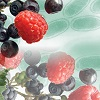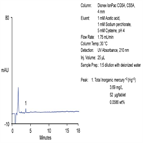Find methods for your needs
Refine by Feature
Displaying 1-5 of 7 results for Tag: IC-ICP-MS
AN355: Rapid Extraction and Determination of Arsenicals in Fish Tissue and Plant Material Using Accelerated Solvent Extraction (ASE)
Instrument Type: Automated Sample PrepThe toxicity of arsenic is species dependent. Inorganic arsenic species such as arsenite (As[III]) and arsenate (As[V]) have been classified as carcinogens. Methylated forms such as monomethylarsonic acid (MMA) and dimethylarsinic acid (DMA) have recently been labeled as cancer promoters. Arsenobetaine (AsB), arsenocholine (AsC), and arseno sugars have been found to be relatively nontoxic. This application note describes ASE methods for the extraction of various arsenic species from different food matrices, specifically fish tissue, ribbon kelp, and vegetables grown in contaminated soil.
AN43227: Speciation of Bromine Compounds in Ozonated Drinking Water using Ion Chromatography and Inductively Coupled Plasma Mass Spectrometry
Instrument Type: ICBromate and brominated organic acids are generated by ozonation of bromide in municipal disinfection processes. The brominated compounds are toxic so compliance monitoring is required. Here four bromine species, including bromate are determined in drinking water using IC coupled to ICP-MS according to a modified U.S. EPA Method 321.8. The ions are separated by IC using a KOH gradient on an IonPac AS19 column. Then the eluting species are detected and quantified by ICP-MS down to ng/L concentrations with negligible spectral interferences using Kinetic Energy Discrimination (KED).
AN43130: Combining the Synergies of Ion Chromatography and Inductively Coupled Plasma to Identify Mercury Contamination in Herbal Medicines
Instrument Type: ICHerbal medicines containing high total mercury concentrations were previously identified (ICP-MS) as the possible cause of several cases of accidental mercury poisoning. Because mercury species have very different toxicities, speciation analysis is needed to determine the patients’ treatment. Here inorganic and organic mercury ions are separated by IC using a mixed eluent (1.0 mM acetic acid, 1 mM sodium perchlorate, 5 mM cysteine, pH = 4.0) on an IonPac CS5A mixed cation-anion-exchange column. The eluting species are detected and quantified by absorbance at 210 nm.
AN43099: IC-ICP-MS speciation analysis of As in apple juice
Instrument Type: ICInorganic and organic arsenic compounds have very different toxicities, and therefore speciation analysis is needed to assess the potential health risk posed by the food product. Here two inorganic and four organic arsenic species are determined in an apple juice sample using IC coupled to iCAP Q ICP-MS. Arsenic species are first separated by IC using an ammonium carbonate gradient on an IonPac AS7 column. Then the eluting species are detected and quantified by the ICP-MS down to ng/g concentrations. Arsenic speciation is also demonstrated in organic brown rice syrup (OBRS) in AN43126.
AN43098: Speciation analysis of Cr (III) and Cr (VI) in drinking waters using anion exchange chromatography coupled to ICP-MS
Instrument Type: ICSpeciation determinations of ionic compounds are important to determine the concentration of the more toxic form in the total elemental composition. Chromium is an industrial waste contaminant that can have serious health effects and therefore requires monitoring in municipal water systems. This method determines Chromium VI and Chromium III species in a municipal drinking water sample. The ions are separated by ion chromatography (IC) on an IonPac AG7 guard column and detected by Inductively Coupled Plasma Mass Spectrometry (ICP-MS) at ng/g. This method is further optimized in AN43175.





